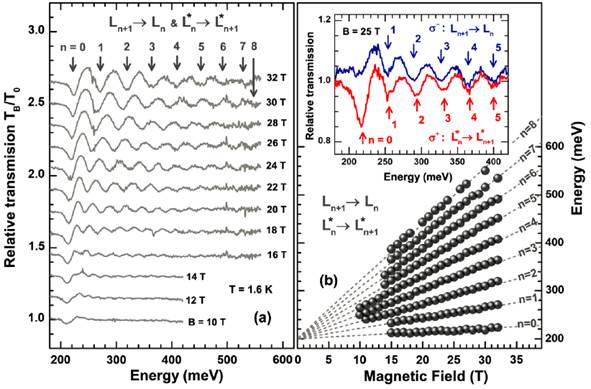The intriguing Dirac-type surface states of topological insulators, protected by time-reversal symmetry, has been explored using a number of various experimental approches, including ARPES, STM/STS, transport or optical techniques. Much less attention has been paid to the bulk properties of topological insulators, even though the apperance of the surface states is governed by the general properties of their bulk Hamiltonians. Recently, we have probed bulk states in Bi2Se3 using Landau level spectroscopy in high magnetic fields. The detailed analysis of results pointed towards a surprising similarity of eletrons and holes in this best-known topological insulator with electrons and positrons in vaccum, which are described in quantum electrodynamics by the Dirac Hamiltonian for massive particles. Such a mapping can be deduced by a detailed analysis of high-field multi-resonance transmission data obtained on thin layers of Bi2Se3 in the quantum regime, see the figure below.

M. Orlita et al., Phys. Rev. Lett. 114, 186401, (2015)
The described similarity allows us to express the g factor nearly equal for electrons and holes in Bi2Se3 using a simple relativistic-like expression ge=gh=2m0 v2/, which connects the energy gap, velocity parameter (effective velocity of light) and free electron mass. Due to rather low energy band gap of Bi2Se3 the electron and hole g factor reaches fairly high values 25 and implies pronounced spin splitting of both conduction and valence bands, see figure below. This significant splitting of bands stands at the origin of surprisingly strong interband Faraday rotation we have been observed in Bi2Se3. The strength of theis rotation, expressed in terms of a large dispersive Verdet constant, see Figure below, is superior of all values ever reported for a non-magnetic material.

L. Ohnoutek et al., Scientific Reports 6, 19087, (2016)
The related effect, a large spin polarization of electrons in n-doped Bi2Se3 has been also recently seen in resistively detected NMR experiments. These experiments, among other, showed that conduction and valance bands in this topological insulators are not as widely assumed formed purely from p-states, but instead, also a significant admixture of high-lying s-states is present.
S. Mukhopadhyay et al., Phys. Rev. B 91,081105(R), (2015)
